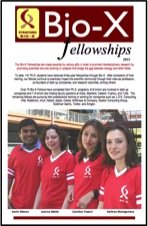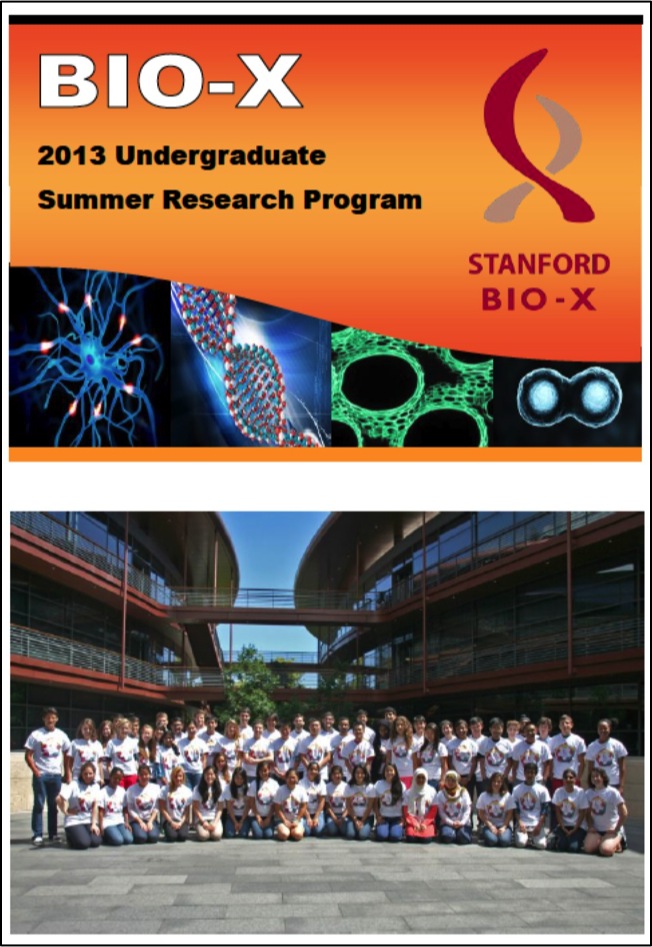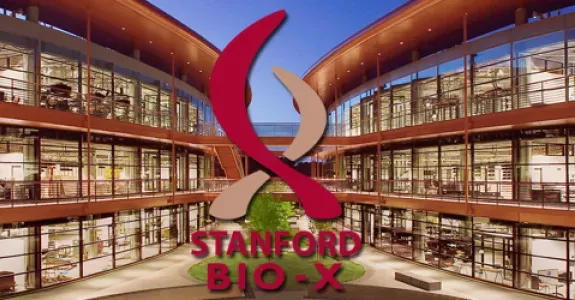
Welcome to the biweekly electronic newsletter from Stanford Bio-X for members of the Bio-X Corporate Forum. Please contact us if you would like to be added or removed from this distribution list, or if you have any questions about Stanford Bio-X or Stanford University.
HIGHLIGHTS
** On October 9, 2013, Bio-X celebrated the 10th Anniversary of the James H. Clark Center, the hub of Bio-X. Check out CLARK CENTER @ 10X on the SPLASH PAGE as well as the Bio-X Timeline over the last 15 years!!
** Check out the article by Stanford President John Hennessy in the Nov/Dec 2013 issue of the Stanford Magazine on Bio-X and the Clark Center, "A Cauldron of Innovation".
Seed Grants
** NEW: Bio-X is pleased to announce its 7th round of requests for Letters of Intent for the IIP Seed Grant Program!!
 SEED GRANTS FOR SUCCESS - Stanford Bio-X Interdisciplinary Initiatives Program (IIP)
SEED GRANTS FOR SUCCESS - Stanford Bio-X Interdisciplinary Initiatives Program (IIP)
The Bio-X Interdisciplinary Initiatives Program represents a key Stanford Initiative to address challenges in human health. The IIP awards approximately $3 million every other year in the form of two-year grants averaging about $150,000 each. From its inception in 2000 through the fifth round in 2010, the program has provided critical early-stage funding to 114 different interdisciplinary projects, involving collaborations from over 300 faculty members, and creating over 450 teams from five different Stanford schools. From just the first 5 rounds, the IIP awards have resulted in a 10-fold-plus return on investment, as well as hundreds of publications, dozens of patents filed, and most importantly, the acceleration of scientific discovery and innovation.
In 2012, Stanford Bio-X selected 23 new seed grant projects as the winners of the 6th round. Please go here to view the list of awardees, along with the titles of their projects and the abstracts of the research. Competition was intense as the awardees were chosen from 118 Letters of Intent (LOIs). Selection criteria included innovation, high-reward, and interdisciplinary collaboration. (To view the 114 other IIP projects that have been funded from the first 5 rounds, please click here.) In addition, SANOFI has also funded 4 new Bio-X IIP Seed Grant projects from round 6!
We are cultivating and are highly successful in building meaningful collaborations with numerous corporate colleagues. New collaborations through our seed grant projects are highly encouraged. To learn about how to get involved, please contact Dr. Hanwei Li or Dr. Heideh Fattaey.
IIP Seed Grants-Related Events
** On Monday, March 3, 2014, Bio-X had a Poster Session, featuring 105 different posters from research by all scientists within the Stanford Bio-X community. Over 250 people attended the session, which allowed for an excellent venue to discuss science and research with colleagues from both academia and industry.
** On Monday, August 26, 2013, Bio-X had its second annual IIP Symposium of the year at the Clark Center, which highlights projects that exemplify the Stanford Bio-X mission of crossing boundaries to bring about interdisciplinary research and solutions in the field of life bioscience. The symposium was a huge success with over 300 people attending this event, which included 8 oral presentations and 136 poster presentations. Recorded talks from the symposium will be uploaded soon. If you'd like to view the talks for previous symposia through the years, please click here.
Fellowships
** NEW: Bio-X is pleased to announce the 11th annual competition for Bio-X Graduate Student Fellowships.
 BIO-X FELLOWSHIPS
BIO-X FELLOWSHIPS
Every year, graduate students and postdoctoral scholars of Bio-X affiliated faculty are highly encouraged to apply for the Bio-X Fellowships, which are awarded to research projects that are interdisciplinary and utilize the technologies of different fields to solve different biological questions. Students are encouraged to work collaboratively with professors of different departments, thus creating cross-disciplinary relationships among the different Stanford schools. Our fellows have conducted exciting research, resulting in publications in high-impact journals and have been offered excellent positions in industry and academia. To date, Stanford Bio-X has a total of 152 Fellows.
On June 26, 2013, Bio-X held its annual Bio-X Fellows Symposium, where there were four 15-minute oral presentations followed by one-minute spiels from current fellows. The 25 newest fellows selected this year were also announced, and about 100 attendees came to the symposium. Please click on the "Bio-X Fellows Symposium" link above for the agenda and titles of the talks, and on the icon of the brochure above for the updated and latest Bio-X Fellowships brochure.
To view the numerous projects that have been awarded over the years, please click here.
** NEW: Bio-X is pleased to announce its 9th call for applications for the Undergraduate Summer Research Program for the summer of 2014.
 BIO-X UNDERGRADUATE SUMMER RESEARCH PROGRAM
BIO-X UNDERGRADUATE SUMMER RESEARCH PROGRAM
The Bio-X Undergraduate Summer Research Program supports undergraduate research training through an award designed to support interdisciplinary undergraduate summer research projects. The program is an invaluable opportunity for students to conduct hands-on research, learn how to carry out experiments in the laboratory, and develop the skills to read and analyze scientific literature.
This program is eligible to Stanford students who want to work in the labs of Bio-X affiliated faculty. To date, 241 students have been awarded the opportunity to participate in the Bio-X Undergraduate Summer Research Program. This summer is Stanford Bio-X's 8th round of USRP.
Participating undergraduates are also required to present poster presentations on the research that they've conducted during the program. Please click here for title lists of past posters that our undergraduates have presented.
Many fruitful collaborations and relationships have been established with industry through fellowships. Please contact Dr. Hanwei Li or Dr. Heideh Fattaey if you'd like to learn more about how to get involved with these fellowship programs.
News
Bioengineer designs diagnostic microscope costing less than $1
Bio-X Affiliated Faculty Manu Prakash
It’s an invention that would make TV’s secret agent MacGyver proud: a fully functional microscope that can be assembled from folded paper and a tiny bead of glass. And it only costs about 50 cents. By adding a watch battery, a light-emitting diode and an on/off switch, it can be configured to diagnose blood-borne diseases such as malaria, African sleeping sickness, schistosomiasis and Chagas — all for under a dollar. The Foldscope is the brainchild of Manu Prakash, PhD, assistant professor of bioengineering. He developed the idea during medical need-finding trips to India, Thailand, Uganda and Nigeria with graduate students James Cybulski and James Clements. During the trip, the team witnessed the deadly toll of infectious diseases including malaria, and noted that many of the remote villages couldn’t afford conventional microscopes or rapid diagnostics tests. “I realized that to make a real impact, we needed to deliver a disease-detection instrument that could almost be distributed for free,” Prakash said. After three years of research, prototyping and extensive field-testing in Southeast Asia and Africa, the Foldscope was born. Design and construction details of this bookmark-sized microscope were released March 5 in arXiv, a scientific paper archive. You can watch the Foldscope in action in the video above and at http://www.ted.com.

 Stanford researchers survey protein family that helps the brain form synapses
Stanford researchers survey protein family that helps the brain form synapses
Bio-X Affiliated Faculty Thomas Südhof and Steve Quake
Neuroscientists and bioengineers at Stanford are working together to solve a mystery: How does nature construct the different types of synapses that connect neurons – the brain cells that monitor nerve impulses, control muscles and form thoughts. In a paper published in the Proceedings of the National Academy of Sciences, Thomas C. Südhof, M.D., a professor of molecular and cellular physiology, and Stephen R. Quake, a professor of bioengineering, describe the diversity of the neurexin family of proteins. Neurexins help to create the synapses that connect neurons. Think of synapses as switchboards or control panels that connect specific neurons when these brain cells must work together to perform a given task. Neurexins play a key role in the formation and functioning of synaptic connections. Past human genetics studies have linked neurexins to a variety of cognitive disorders, such as autism and schizophrenia. Südhof, the Avram Goldstein Professor in the School of Medicine and a winner of the 2013 Nobel Prize in Medicine, has spent years studying the many different forms, or isoforms, of neurexin proteins. He has postulated that different isoforms of neurexins may help to create different types of synaptic connections with distinct properties and functions, and thus enable neurons to do so many complex tasks. But Südhof had no way to know exactly how many isoforms of neurexins existed until he sat down last year with Quake, the Lee Otterson Professor in the School of Engineering. Quake has pioneered new ways to sequence DNA – the master blueprint that nature follows when making proteins. The study being published in PNAS represents the results of a year-long collaboration between neuroscientists and bioengineers to better understand how different neurexin proteins affect the behavior of synapses and, ultimately, normal brain functions and neurological conditions such as autism.
 Stanford scientists develop technique for observing behavior of single molecules in real time
Stanford scientists develop technique for observing behavior of single molecules in real time
Bio-X Affiliated Faculty WE Moerner
Nearly every biological or chemical reaction that makes life possible involves single molecules interacting in the watery solution that sloshes in and around cells. Now, a Stanford chemistry professor and his graduate student have developed a technique for observing these processes as they happen in real time. W.E. Moerner, a professor of chemistry, specializes in single molecule fluorescence, a field that involves studying how biomolecules – such as DNA and enzymes – work in cells to carry out the processes that are critical to life. The new advance describes how Moerner and his graduate student, Quan Wang, modified an ABEL (Anti-Brownian ELectrokinetic) trap, a machine invented in Moerner's lab that uses electric fields to manipulate individual small molecules from the light they emit, to isolate a single strand of DNA and observe how it binds to other DNA, in aqueous solution. The work is detailed in the journal Nature Methods.
 Study identifies new drug target for chronic, touch-evoked pain
Study identifies new drug target for chronic, touch-evoked pain
Anesthesia Faculty Gregory Scherrer
Researchers at the School of Medicine have identified a subset of nerve cells that mediates a form of chronic, touch-evoked pain called tactile allodynia, a condition that is resistant to conventional pain medication. The discovery could point researchers to more fruitful efforts to develop effective drugs for the condition. Touch-evoked pain occurs as part of a larger neuropathic pain condition arising from damage or disruption of nerve-cell circuits or signals caused by disorders such as alcoholism, diabetes, shingles and AIDS, or procedures such as spine surgery and chemotherapy. For patients with tactile allodynia, the slightest touch — a gentle caress or the brush of shirt against skin — can cause excruciating pain because changes in nerve-cell signals or networks trick the brain into mistaking touch for pain. The study, published online Feb. 27 in Neuron, found that these "touch" neurons are different from the usual "pain" neurons that respond to stimuli such as cuts or bruises.
Events
| Biochemistry March 26, 2014, 4 pm - 5 pm Clark Center Auditorium, Stanford, CA FRONTIERS IN BIOLOGY - "Reprogramming Approaches for Cardiovascular Disease" Speaker: Deepak Srivastava, UCSF |
Neurosciences Institute March 27, 2014, 12 pm - 1 pm Clark Center Auditorium, Stanford, CA "Neuronal circuits for pattern classification in the olfactory system" Speaker: Rainer Friedrich, PhD, Friedrich Miescher Inst for Biomedical Research |
Resources
| Stanford University |
| Stanford Bio-X |
| Bio-X Seed Grants The Stanford Bio-X Interdisciplinary Initiatives Program (IIP) provides seed funding for high-risk, high-reward, collaborative projects across the university, and have been highly successful in fostering transformative research. |
| Office of Technology and Licensing "Techfinder" Search the OTL Technology Portal to find technologies available for licensing from Stanford. |
| Stanford Center for Professional Development - Take advantage of your FREE membership! - Take online graduate courses in engineering, leadership and management, bioscience, and more. - Register for free webinars and seminars, and gets discounts on courses. |
| Stanford Biodesign Video Tutorials on how FDA approves medical devices A series of video briefs recently produced by the Stanford Biodesign Program teaches innovators how to get a medical device approved for use in the United States. This free, online library of 60 videos provides detailed information on the Food and Drug Administration regulatory process, short case studies and advice on interacting with the FDA. |
To learn more about Stanford Bio-X or Stanford University, please contact Dr. Hanwei Li, the Bio-X Corporate Forum Liaison, at 650-725-1523 or lhanwei1@stanford.edu, or Dr. Heideh Fattaey, the Executive Director of Bio-X Operations and Programs, at 650-799-1608 or hfattaey@stanford.edu.

